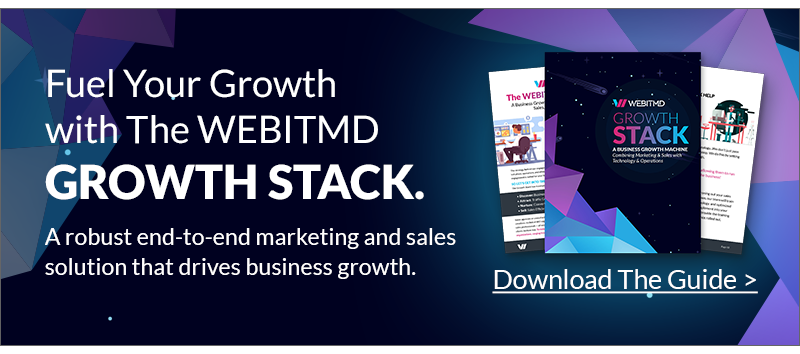Marketing departments require an assortment of marketing tools and technologies to operate in the digital age. This is what we call a martech stack and it is one the most important assets to any business.
But before you start chasing the latest and greatest, it’s important to have a solid marketing strategy in place first. Then, you can select the right tools to help you execute that strategy.
Here are some tips to help you build a martech stack for your business.
What is a Martech Stack?
A martech stack – also called a marketing tech stack or a marketing technology stack – is a collection of technologies that marketing departments use to perform, improve, and analyze various marketing activities.
The way a tech stack is built will vary from business to business. The tools you use will depend on the goals of your organization, the strategies you deploy, and the challenges you face.
Examples of tools you will find in a martech stack might include:
- Keyword research tools
- Social media publishing tools
- Email marketing platforms
- Marketing automation
- Customer Relationship Management (CRM)
- Content Management System (CMS)
- Google Ads platform
- And more
How Does Technology Help Marketing?
Technology stacks are at the core of every marketing department. With the right tools and software at their disposal, marketers can be more efficient, productive, and strategic in their day-to-day work.
For example, if your marketing team spends the bulk of their time sending emails or updating contact records, you can use marketing automation to automate those tasks. This would free up a lot of time and allow your team to work on more impactful projects.
Or, if content marketing is a big part of your marketing strategy, keyword research tools can help your team find relevant keywords and attract more organic traffic to your website.
Technology helps marketing teams do their jobs better. With the right martech stack, even small businesses can compete with the largest companies in their space.
Building Your Marketing Tech Stack
With over 8,000 martech solutions available, it’s tempting to just purchase the latest and greatest and call it a day. But that approach could end up costing you more money than it saves.
Here are some tips to follow when building a martech stack:
1. Know Your Goals and Strategies
Marketing technology by itself won’t grow your business. Any tools you use should support your overarching marketing strategy.
Before you begin researching the latest marketing technologies, you need to understand your goals and strategies and then build a tech stack that will help you get there. For example, you could follow a framework similar to this:
Goal: Increase organic traffic
Strategy: SEO
Technology: TBD
Or
Goal: See higher lead-to-customer rates
Strategy: Improve marketing and sales alignment
Technology: TBD
You should also look at the strategies that are currently in place and see if there is any room to improve them with new marketing tools. The tools you are currently using could be outdated or there could be a better solution available so it’s important to perform a technology audit at least once a year.
2. Identify Challenges and Roadblocks
Once you have your goals and strategies in place, it’s time to look ahead and identify potential challenges or roadblocks. Think about how technology can help your team be successful. Interview members of your team and ask questions such as:
- What tasks take the most time and what would make them more efficient?
- What is the most difficult part of your job?
- What part of your job do you enjoy the least?
- What are the biggest obstacles you face?
It’s important to get specific and connect the responses to your marketing goals. Consider using the following framework to structure the data you are collecting:
Goal: Outrank competitors in organic search results
Strategy: SEO
Challenge: Lack of insight into competitors
Technology: Keyword research tool for competitor analysis
Or
Goal: See higher lead-to-customer rates
Strategy: Improve marketing and sales alignment
Challenge: Hard to share data between departments
Technology: Central CRM to store and share customer data
It’s important to be strategic with your adoption of new marketing technology. Chasing the new shiny thing just because it’s “the best” isn’t always the right approach.
Understand your current situation, create goals, develop strategies, and identify challenges. Then build a martech stack that will accomplish what you need it to.
3. Establish Your Budget
Technology should always be used to improve your current situation without creating a whole new set of problems. This is why it’s important to set a budget before shopping around.
Avoid paying for features you don’t need as much as possible. Don’t just pick the “industry leader” because you want the best. Take the time to research what you really need and choose the platform that has the right capabilities but without a ton of bells and whistles you will never use.
For example, if you are a small e-commerce business and your strategy is to generate return customers through email marketing, A standard MailChimp plan may serve your needs just fine. But if you have a bigger budget and want a tool that will continue to provide more value as your business grows, an all-in-one marketing and sales CRM like HubSpot would be worth the extra investment.
4. Research Your Options
Now that you have your goals, strategy, and budget laid out, it’s time to start researching your options.
The marketing technology world is massive and there are new tools arriving constantly. A good starting point is to ask your team members what tools they recommend. You can also do research online and read product curation posts to find out which solutions are the most widely recommended.
A well-rounded marketing tech stack will usually include an assortment of the following tools:
- SEO: Semrush, Google Analytics, Google Analytics
- Email Marketing: MailChimp, HubSpot, ActiveCampaign
- Marketing Automation: Marketo, HubSpot, Customer.io
- Social Media: Hootsuite, BuzzSumo, PostBeyond
- CMS: WordPress, HubSpot, Magento
- CRM: Salesforce, Zoho, HubSpot
- Paid Advertising: Google Ads, SpyFu, Unbounce
5. Ensure Compatibility
This is where it starts to get a little complicated. Once you have compiled a list of martech tools you are interested in, you need to do your due diligence and make sure they are all compatible with one another.
I cannot stress this enough.
There is nothing more frustrating than signing an annual contract for a new marketing automation platform only to find out that it doesn’t integrate with your CRM.
Ask the tough questions. Talk to representatives on both sides. Talk to your team. Talk to existing users to see what pain points they have experienced and what advice they can give you. Just don’t assume everything will work out the way you want it to.
Trust me.
6. Implement Your Solution
Now that you have your martech stack finalized, it’s time to implement. The amount of time it takes to fully implement new marketing technology in your business will vary depending on the complexity of the solution.
In some cases, it can be as simple as creating a business account and logging into the platform. But if you are migrating to a new CRM or CMS, the onboarding process can take several weeks.
I also recommend baking in some time for training and tutorials. It can take awhile for your team to learn the ins and outs of a new software. It really depends on the complexity of the solution and how much in-house expertise your company has available.
Building A Martech Stack That Works For You
Technology should be used to make our lives easier. Your martech stack should be built around your current goals, strategies, and limitations.
With so many different solutions available, it’s hard to know what’s what. WEBITMD is a growth marketing agency with expertise in marketing strategy and technology implementation. We can help you sift through the noise and build a martech stack that works for you. We even provide ongoing support to ensure you are getting the most value from your toolset.
To learn more about how we can help grow your business through marketing strategy and technology, download your free Growth Stack guide today!



.jpg)




(1).jpg)

.jpg)



![5 Reports to Elevate Your HubSpot Sales Dashboard [+ Examples]](https://2363531.fs1.hubspotusercontent-na1.net/hub/2363531/hubfs/Imported_Blog_Media/6-winning-examples-of-a-hubspot-sales-dashboard-2.png?width=767&name=6-winning-examples-of-a-hubspot-sales-dashboard-2.png)

